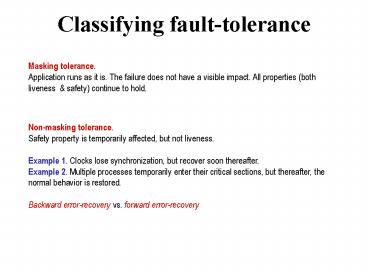Classifying fault-tolerance PowerPoint PPT Presentation
Title: Classifying fault-tolerance
1
Classifying fault-tolerance
Masking tolerance. Application runs as it is.
The failure does not have a visible impact. All
properties (both liveness safety) continue to
hold.
Non-masking tolerance. Safety property is
temporarily affected, but not liveness. Example
1. Clocks lose synchronization, but recover soon
thereafter. Example 2. Multiple processes
temporarily enter their critical sections, but
thereafter, the normal behavior is
restored. Backward error-recovery vs. forward
error-recovery
2
Backward vs. forward error recovery
Backward error recovery When safety property is
violated, the computation rolls back and resume
from a previous correct state.
time
rollback
Forward error recovery Computation does not care
about getting the history right, but moves on, as
long as eventually the safety property is
restored. True for stabilizing systems.
3
Classifying fault-tolerance
Fail-safe tolerance Given safety predicate is
preserved, but liveness may be affected Example.
Due to failure, no process can enter its critical
section for an indefinite period. In a traffic
crossing, failure changes the traffic in both
directions to red.
Graceful degradation Application continues, but
in a degraded mode. Much depends on what kind
of degradation is acceptable. Example. Consider
message-based mutual exclusion. Processes will
enter their critical sections, but not in
timestamp order.
4
Failure detection
- The design of fault-tolerant systems will be
easier if failures can be detected. Depends on
the - 1. System model, and
- 2. the type of failures.
- Asynchronous systems are more tricky. We first
focus on synchronous systems only.
5
Detection of crash failures
- Failure can be detected using heartbeat messages
- (periodic I am alive broadcast) and timeout
- - if the largest time to execute a step is known
- - channel delays have a known upper bound.
6
Detection of omission failures
- For FIFO channels Use sequence numbers with
messages. - Non-FIFO channels and bounded propagation delay -
use timeout - What about non-FIFO channels for which the upper
bound of the - delay is not known? Use unbounded sequence
numbers and - acknowledgments. But acknowledgments may be lost
too, causing - unnecessary re-transmission of messages - (
- Let us look how a real protocol deals with
omission .
7
Tolerating crash failures
- Triple modular redundancy (TMR)
- for masking any single failure.
- N-modular redundancy masks
- up to m failures, when N 2m 1
Take a vote
What if the voting unit fails?
8
Tolerating omission failures
- Central theme in networking
router
A
Routers may drop messages, but reliable
end-to-end transmission is an important
requirement. This implies, the communication
must tolerate Loss, Duplication, and Re-ordering
of messages
B
router
9
Stennings protocol
- program for process S
- define ok boolean next integer
- initially next 0, ok true, both channels are
empty - do ok ? send (mnext, next) ok false
- (ack, next) is received ? ok true next
next 1 - ? timeout (r,s) ? send (mnext, next)
- od
- program for process R
- define r integer
- initially r 0
- do (m , s) is received ? s r ? accept
the message - send (ack, r)
- r r1
- ? (m , s) is received ? s?r ? ???? (ack, r-1)
- od
Sender S
m0, 0
ack
Receiver R
10
Observations on Stennings protocol
Sender S
- Both messages and acks may be lost
- Q. Why is the last ack reinforced by R when s?r?
- A. Needed to guarantee progress.
- Progress is guaranteed, but the protocol
- is inefficient due to low throughput.
m0, 0
ack
Receiver R
11
Sliding window protocol
The sender continues the send action without
receiving the acknowledgements of at most w
messages (w gt 0), w is called the window size.
12
Sliding window protocol
- program for process S
- define next, last, w integer
- initially next 0, last -1, w gt 0
- do last1 next last w ?
- send (mnext, next) next next 1
- (ack, j) is received ?
- if j gt last ?????last j
- ? j last ? skip
- fi
- timeout (R,S) ? next last1
- retransmission begins
- od
- program for process R
- define j integer
- initially j 0
- do (mnext, next) is received ?
- if j next ? accept message
- send (ack, j)
- j j1
- ? j ? next ? send (ack, j-1)
- fi
- od
13
Why does it work?
- Lemma. Every message is accepted exactly once.
- Lemma. mk is always accepted before mk1.
- (Argue that these are true.)
- Observation. Uses unbounded sequence number.
- This is bad. Can we avoid it?
14
Theorem
- If the communication channels are non-FIFO, and
the message propagation delays are arbitrarily
large, then using bounded sequence numbers, it is
impossible to design a window protocol that can
withstand the (1) loss, (2) duplication, and (3)
reordering of messages.
15
Why unbounded sequence no?
(m,k)
(mk,k)
(m, k)
New message using the same seq number k
Retransmitted version of m
We want to accept m but reject m. How is that
possible?

